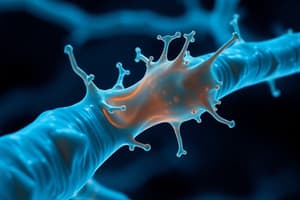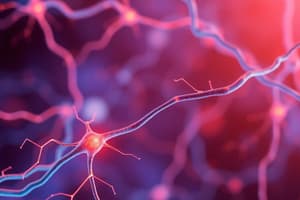Podcast
Questions and Answers
Which neurotransmitter is primarily responsible for mood regulation?
Which neurotransmitter is primarily responsible for mood regulation?
- GABA
- Dopamine
- Acetylcholine
- Serotonin (correct)
Neurons are primarily responsible for providing structural support for the brain.
Neurons are primarily responsible for providing structural support for the brain.
False (B)
What is the term for the state when the inside of a neuron becomes less negative due to sodium influx?
What is the term for the state when the inside of a neuron becomes less negative due to sodium influx?
Depolarization
The primary role of the _____ pump is to maintain the resting state of a neuron by pumping sodium out and potassium in.
The primary role of the _____ pump is to maintain the resting state of a neuron by pumping sodium out and potassium in.
Match the following types of neurons with their functions:
Match the following types of neurons with their functions:
What is the primary role of the myelin sheath?
What is the primary role of the myelin sheath?
The cerebellum is primarily responsible for reasoning and decision-making.
The cerebellum is primarily responsible for reasoning and decision-making.
What is the definition of status epilepticus?
What is the definition of status epilepticus?
The ______ lobe is primarily associated with vision.
The ______ lobe is primarily associated with vision.
Which of the following is NOT a type of seizure?
Which of the following is NOT a type of seizure?
Match the type of seizure with its description:
Match the type of seizure with its description:
Epilepsy is characterized by recurrent seizures and can be caused by head trauma.
Epilepsy is characterized by recurrent seizures and can be caused by head trauma.
Name one medical treatment option for epilepsy.
Name one medical treatment option for epilepsy.
What is the most common type of primary headache?
What is the most common type of primary headache?
Myasthenia Gravis is an autoimmune disease characterized by muscle weakness and fatigue.
Myasthenia Gravis is an autoimmune disease characterized by muscle weakness and fatigue.
What class of medications is typically used as the first line treatment for anxiety?
What class of medications is typically used as the first line treatment for anxiety?
In Huntington's Disease, the abnormal protein that disrupts the brain's function is called __________.
In Huntington's Disease, the abnormal protein that disrupts the brain's function is called __________.
Which of the following is NOT a secondary headache cause?
Which of the following is NOT a secondary headache cause?
What is the primary symptom of Parkinson's Disease?
What is the primary symptom of Parkinson's Disease?
Match the following treatments with their corresponding conditions:
Match the following treatments with their corresponding conditions:
Sudden Unexpected Death in Epilepsy (SUDEP) often occurs during waking hours.
Sudden Unexpected Death in Epilepsy (SUDEP) often occurs during waking hours.
Which treatment is used specifically for cluster headaches?
Which treatment is used specifically for cluster headaches?
In Alzheimer’s disease, the accumulation of __________ tangles is a key feature.
In Alzheimer’s disease, the accumulation of __________ tangles is a key feature.
What is a common symptom of Trigeminal Neuralgia?
What is a common symptom of Trigeminal Neuralgia?
Multiple Sclerosis is caused by the degeneration of motor neurons.
Multiple Sclerosis is caused by the degeneration of motor neurons.
What age group is most affected by Sudden Unexpected Death in Epilepsy (SUDEP)?
What age group is most affected by Sudden Unexpected Death in Epilepsy (SUDEP)?
What is the mechanism of action for Donepezil in treating Alzheimer's disease?
What is the mechanism of action for Donepezil in treating Alzheimer's disease?
Which condition is characterized by painless muscle weakness and atrophy?
Which condition is characterized by painless muscle weakness and atrophy?
Flashcards
Central Nervous System
Central Nervous System
The control center of the body, consisting of the brain and spinal cord.
Peripheral Nervous System
Peripheral Nervous System
The network of nerves that connect the central nervous system to the rest of the body, enabling communication and control.
What is acetylcholine responsible for?
What is acetylcholine responsible for?
Acetylcholine (ACh) plays a crucial role in muscle movement, memory, and learning.
What is GABA responsible for?
What is GABA responsible for?
Signup and view all the flashcards
What is the role of the sodium-potassium pump in nerve conduction?
What is the role of the sodium-potassium pump in nerve conduction?
Signup and view all the flashcards
Refractory Period
Refractory Period
Signup and view all the flashcards
Myelin Sheath
Myelin Sheath
Signup and view all the flashcards
Frontal Lobe Function
Frontal Lobe Function
Signup and view all the flashcards
Substantia Nigra
Substantia Nigra
Signup and view all the flashcards
Channelopathies
Channelopathies
Signup and view all the flashcards
Epilepsy
Epilepsy
Signup and view all the flashcards
Seizure
Seizure
Signup and view all the flashcards
Status Epilepticus (SE)
Status Epilepticus (SE)
Signup and view all the flashcards
First line treatment for seizures
First line treatment for seizures
Signup and view all the flashcards
SUDEP
SUDEP
Signup and view all the flashcards
Upper Motor Neuron
Upper Motor Neuron
Signup and view all the flashcards
Lower Motor Neuron
Lower Motor Neuron
Signup and view all the flashcards
Tension Headache
Tension Headache
Signup and view all the flashcards
Migraine Headache
Migraine Headache
Signup and view all the flashcards
Trigeminal Autonomic Cephalgia (TAC)
Trigeminal Autonomic Cephalgia (TAC)
Signup and view all the flashcards
Secondary Headache
Secondary Headache
Signup and view all the flashcards
Parkinson's Disease
Parkinson's Disease
Signup and view all the flashcards
Amyotrophic Lateral Sclerosis (ALS)
Amyotrophic Lateral Sclerosis (ALS)
Signup and view all the flashcards
Multiple Sclerosis (MS)
Multiple Sclerosis (MS)
Signup and view all the flashcards
Huntington's Disease
Huntington's Disease
Signup and view all the flashcards
Guillain-Barré Syndrome (GBS)
Guillain-Barré Syndrome (GBS)
Signup and view all the flashcards
Myasthenia Gravis (MG)
Myasthenia Gravis (MG)
Signup and view all the flashcards
Dementia
Dementia
Signup and view all the flashcards
Study Notes
Basic Neurological Concepts
- Central Nervous System (CNS) includes the brain and spinal cord
- Peripheral Nervous System (PNS) includes: somatic nerves (motor and sensory) and autonomic nervous system
- Neurons conduct electrical signals. Types include motor, sensory, and interneurons
- Glial cells support neurons structurally
- Neurotransmitters have specific functions
- Acetylcholine (ACh): muscle movement, memory, learning
- Serotonin: mood regulation, appetite, sleep
- Dopamine: movement, memory, behavior
- GABA: calms brain, prevents anxiety or convulsions
- Norepinephrine: alertness, stress response (BP and HR)
- Glutamate: learning and memory
- Nerve Conduction (pg 823):
- Resting state: inside of neuron is more negative than outside, maintained by sodium-potassium pump (3 Na+ out, 2 K+ in)
- Depolarization: stimulus triggers neuron, sodium (Na+) channels open, Na+ rushes into cell, making inside less negative/more positive
- Repolarization: after peak of depolarization, potassium (K+) channels open, K+ flows out of cell, restoring negative charge inside
- Hyperpolarization: cell briefly becomes more negative than its resting state due to excess K+ leaving.
- Return to resting state: sodium-potassium pump restores the original ion balance. This process allows nerve signals to travel down the axon efficiently. A healthy body needs this refractory period (rest time) before the next signal.
Myelin Sheath
- Protective layer around the axon
- White matter - insulator
- Helps nerve conduction move quicker
- Degeneration of myelin sheath (e.g., MS, ALS) impairs nerve impulse travel
Brain
- Frontal Lobe: reasoning
- Parietal Lobe: spatial understanding
- Temporal Lobe: memory, language
- Brainstem: communications with the rest of the body (HR, BP)
- Occipital Lobe: vision
- Cerebellum: balance
- Substantia Nigra: synthesis of dopamine (Behavior, Movement, Memory)
- Ion Channel Disorders: are called Channelopathies
Seizures
- Sudden, abnormal, disorderly discharge of neurons within the brain
- Traditional Diagnosis: Two unprovoked seizures at least 24 hours apart
- Etiology may include head trauma, stroke, brain neoplasm (cancer), Alzheimer's disease, genetic factors, congenital conditions, infections, electrolyte imbalances, and detoxification.
- Types: Focal (one hemisphere; can be seen on EEG), generalized (both hemispheres)
- Terminology: Motor, non-motor, or both; Clonic (sustained rhythmic jerking), Atonic (weak or limp muscles), Myoclonus (muscle twitching), Non-motor symptoms (staring spells without movement), Aura (sensation before a seizure)
- Status Epilepticus: seizure lasting more than 5 minutes or multiple seizures in a short period
- SUDEP (Sudden Unexpected Death in Epilepsy): unsure of exact cause, often during sleep, 20-40 yrs old
Headaches
- Primary headaches are not due to other medical issues
- Tension Type: most common, does not worsen with movement, no nausea/vomiting, bilateral pain, pain relievers may help.
- Migraines: comes in four stages, serotonin decreases, calcitonin gene-related peptide (CGRP) increases; often periodic, throbbing, worsening with movement; photophobia and phonophobia (light and sound sensitivity), often nausea; auras are seen in 75% of cases. Treatment options include NSAIDs, SSRIs (triptans), dopamine receptor antagonists, triggers, Botox, injections.
- Trigeminal autonomic cephalgia (TAC): cluster headache most common has to do with eyes; bloodshot eyes, pupil constriction, eyelid edema
- Secondary Headaches: caused by another medical condition
- Head injuries, vascular problems, medication side effects, sinus problems, tumors, trigeminal neuralgia,
Parkinson's Disease
- Progressive loss of dopamine-producing cells in the substantia nigra
- Unknown etiology
- Movement affected by dopamine imbalance, (acetylcholine stimulates muscle movement, while dopamine is inhibitory).
Amyotrophic Lateral Sclerosis (ALS)
- Painless muscle weakness and atrophy due to death of motor neurons in the brain and spinal cord.
- Secondary death of myelin sheath
- UMN (brain): increased muscle tone, slow movement, hyperreflexia, and Babinski sign (toes spread apart).
- LMN (lower): decreased strength and weakness, clumsiness, gait disturbances, issues with chewing, swallowing, and speaking.
- No cure
Multiple Sclerosis (MS)
- Chronic demyelinating disorder affecting the brain, spinal cord, and optic nerves
- Loss of myelin sheath
- Symptoms include weakness, numbness, balance problems, abstract reasoning problems, and attention issues.
- Depression may be involved
Huntington's Disease (HD)
- Mutated gene where the abnormal repetition of DNA bases disrupts the protein "huntingtin"
- Symptoms include involuntary motor symptoms (dyskinesia, chorea, athetosis), cognitive decline (apathy, slowed thought process), emotional/behavioral symptoms (major depressive disorder).
- There is no cure
Guillain-Barré Syndrome (GBS)
- Acute inflammatory demyelination, a post-infectious disease
- Follows respiratory illness or gastroenteritis
- Recovery over a long period of time
- Symmetrical ascending muscular weakness
- Diminished deep tendon reflexes and sensory loss.
Myasthenia Gravis (MG)
- Autoimmune disease where antibodies attack acetylcholine receptors
- Symptoms and treatment include weakness (often extraocular muscles, "true fatigue"), and improve with rest.
Dementia
- Decline in reasoning, memory, judgment. and other cognitive functions
- Difficulty with activities of daily living (ADLs)
- Main causes include Alzheimer's disease and Lewy body dementia.
- Symptoms include anomia, amnesia, anxiety, agnosia, apraxia, apathy, and aphasia.
Other Diseases
- Note additional neurological disorders mentioned (e.g., Alzheimer's Disease, Vascular Dementia, Lewy Body Dementia, with associated symptoms and classifications)
- Note any treatments (e.g., medication names, therapies) that are mentioned.
Studying That Suits You
Use AI to generate personalized quizzes and flashcards to suit your learning preferences.




